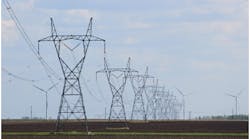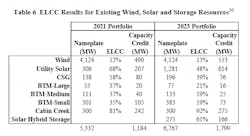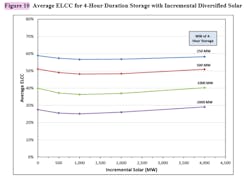Higher concentrations of solar interconnecting and thermal units retiring enable the Directors of Resource Planning at transmission utilities to adapt the capacity credit calculations of wind for solar. But how to calculate capacity credit for distributed scale solar? Taking Xcel Energy in Minnesota and Colorado as examples, this article shows how Effective Load Carrying Capability calculation helps inform state regulators about future capacity needs.
Since distributed solar and storage also provide capacity value in resource plans, transmission utilities must adapt their capacity credit calculations to include distributed resource modeling.
Why calculate Capacity Credit for solar?
Dispatchable resources like coal, natural gas, and diesel are predictable, and transmission utility operators have had experience running them for decades. But most new interconnections are solar and are not predictable due to cloud cover and weather patterns. Sophisticated solar production forecasting models address the operational part of the need, not the planning, which looks beyond 2 weeks.
Moreover, operators do not have multiple decades of experience relying on solar for capacity. Hence there is a need to assign a value for solar capacity. This need leads to a complex calculation called Effective Load Carrying Capability (ELCC).
Don't confuse capacity credit/value with the capacity factor
The capacity credit calculation is not the same as the capacity factor. If the nameplate capacity for a solar farm is 100 MW, then a capacity factor of 20% indicates that out of the 100 MW, it is expected that 20 MW is produced.
Capacity credit, however, deals with what % of that nameplate capacity is worth in the resource plan or assumed in the Power Purchase Agreement (PPA). In these capacity credit calculations, when there are fewer resources, they are usually worth more in capacity value than when there are hundreds of resources of the same kind. A greater number of units mean better reliability and less chance of that loss of load event.
Xcel Energy Minnesota IRP focuses on average ELCC
With this background, we focus on resource planning studies where Xcel Energy employs this complex capacity credit calculation called ELCC. Learning from Xcel Energy's experience is valuable for other transmission utilities because Xcel operates and participates in resource planning in 8 states, including Colorado, Michigan, Minnesota, New Mexico, North Dakota, South Dakota, Texas, and Wisconsin. Additionally, Xcel announced a commitment to 100% carbon-free electricity by 2050 with an 80% reduction in carbon emissions by 2030.
Before the Minnesota state regulator approved the 2020-2034 Upper Midwest Integrated Resource Plan in Feb. 2022, Xcel Energy in Minnesota underwent several iterations starting in May 2019. Initially, Xcel decided to replace a retiring coal unit with a gas unit. But after extensive stakeholder comments, changed that gas plan to utility-scale solar. ELCC calculations were extensively used to show the declining capacity values of solar (from 50% to 30%) in the later years of the study period.
Additionally, the Xcel MN plan compared the generic capacity factor (not capacity value) of distributed solar - residential and commercial to the utility-scale solar. If the wind has a generic capacity factor of 50%, utility-scale solar is 22%, and distributed solar is 18%. But Xcel did not run ELCC to show the capacity value of distributed solar at residential and commercial levels.
ELCC shows the locational capacity value of a resource. For example, Xcel said in the initial iteration of the IRP, "We note that we have shifted from using the MISO footprint average wind ELCC of 15.6% to the most recent Zone 1 specific ELCC of 16.7%, in order to better capture the higher locational value of wind resources in our specific region". Vote Solar, the Institute for Local Self Reliance, Cooperative Energy Futures, and the Environmental Law and Policy Center (collectively "Distributed Solar Parties") raised this locational value of distributed solar topic in their comments and expressed concern with the lack of ELCC calculations comparing utility-scale solar to distributed solar in Xcel's IRP.
Based on one of the Distributed Solar Parties recommendations, the Minnesota Commission directed Xcel "to use a consistent forecast of distributed energy resources in both its resource planning docket and its Integrated Distribution Planning docket."
Xcel - Public Service Company of Colorado ERP shows marginal ELCC produces lower capacity compared to average ELCC
Public Service Company of Colorado (PSCo), an Xcel Energy company operating in Colorado, submitted a resource planto the Colorado Public Utilities Commission. The latest plan was the 2021 Electric Resource Plan (ERP). In PSCo's ERP, ELCC calculations were run extensively to show that marginal ELCCs are significantly lower than average ELCCs. And solar + storage capacity value is higher than standalone solar or storage.
Marginal ELCC looks at the next incremental MW required to provide that capacity in the Loss of Load Expectation (LOLE) model to meet the reliability criteria of one day in 10 years. An average ELCC is looking at averaging the ELCC calculated at those top 8 peak load hours contributing to load shed events. Most of the historical ELCC studies are average ELCC methods. Some of the newer ELCC variations are marginal. These are looking at where the next MW capacity could come from - solar, storage, or any other dispatchable resource available during those emergency conditions.
Unlike in Minnesota IRP, PSCo does calculate the ELCC for distributed solar, specifically behind the meter (BTM) solar in its ERP. And found that existing BTM solar capacity credit reduced in 2023 compared to 2021 values in all 3 categories - Large, Medium, and Small. This existing resource finding led to adding more future renewable resources to meet future forecasted demand in PSCo's ERP.
As part of a settlement agreement filed with the Colorado commission, PSCo agreed to update with ELCC calculation for four-hour duration standalone storage and assign a 60% average ELCC value to the first 500 MW storage component of hybrid (storage plus solar) projects and 40% for any incremental storage capacity.
Conclusion
Capacity credit calculations in resource planning will get complicated with the introduction of distributed solar and storage to utility-scale solar. Xcel's experience is typical and provides lessons for the utility resource planning directors.



